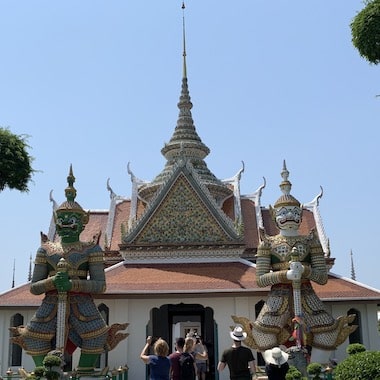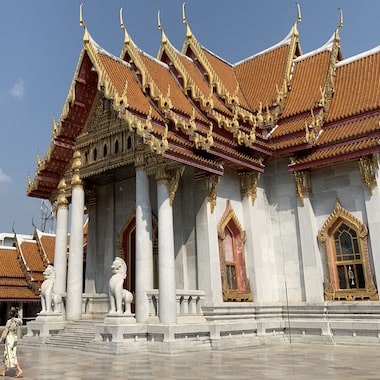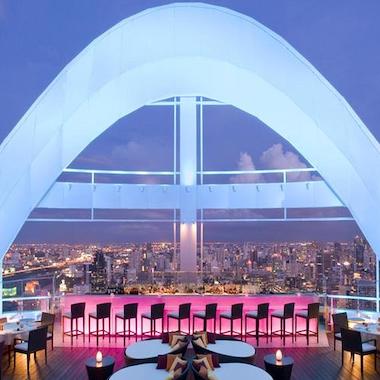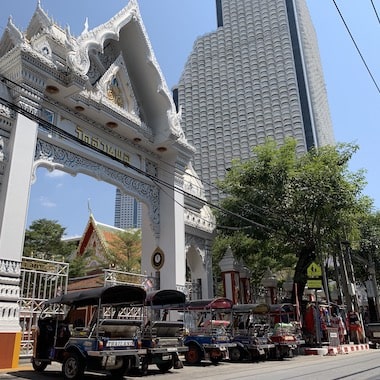ADVANCE PLANNING -- KNOW BEFORE YOU GO
WHEN TO GO: Bangkok is a year-round destination, but its tropical climate is more pleasant at different times of the year. No matter when you go, it will be hot and humid, but the cooler days are between November and January (December is the coolest, with average high temperatures reaching 26°C/79°F). Take an umbrella between May and November, as that’s the unpredictable rainier season, but it will still be warm and the rains rarely last more than one or two hours at a time. The highest temperatures happen between March and May, with April being the hottest and most uncomfortable month (the average high is 35°C/95°F). The peak tourist season is December and January.
In April you’ll catch the Thai New Year celebrations, while in May you’ll see candlelight processions around important temples, marking Buddha’s Enlightenment. Another major event is the Golden Mount Fair in November, with performances and processions at the foot of the Golden Mount.
VISAS: Citizens from the United States, Australia, and most of Europe can enter Thailand without a pre-arranged visa. You’ll be allowed to stay for 30 days, but those wishing to stay longer can acquire a 60-day tourist visa from a Thai embassy or consulate prior to arrival. You should do that about one month before your departure date.
BOOKINGS: You should book your hotel about three months in advance for the most popular luxury or boutique hotels, especially if you’re staying in December or January. Not only will you have a better chance of getting the preferred room, you’ll also have the best rates. If you’re interested in a tour, book it one week before.
If you’re wondering where you should book your room, see our guide to the best neighborhoods to stay in Bangkok.
HOW MANY DAYS IN BANGKOK? Although many people stay in Bangkok for just two or three days, before or after the Thai beach resort experience, it’s not uncommon for visitors to extend their time to as much as one week or more. You can see the main sights in just two days, but, with its many rooftop pools and bars, spas and massages, Bangkok is also a city for relaxation and pampering, not meant to be rushed. For the full experience, plan at least five days in the city.
WHAT’S NEW IN BANGKOK IN 2022?
The COVID-19 pandemic has put many projects on hold around the world, including in Bangkok, but there are still new attractions in the city to enjoy in 2022. Despite the devastating effects of the pandemic on the travel industry, Bangkok has inaugurated two major new hotels, both located in the same compound on the riverfront. Those are the luxurious Capella Hotel and the Four Seasons Hotel Bangkok.
Also new is Paradise Lost, a tropical-inspired and eco-friendly rooftop bar at the design hotel Siam@Siam.
Then there’s the city’s ever-expanding transport network. After the new stations of the MRT (the underground metro), which now offer faster connections to popular neighborhoods like Chinatown and the Old City (and they are some quite beautiful stations, especially Wat Mangkon Station, which is decorated with traditional Chinese motifs), come new stations for the BTS Skytrain, although these are on the northbound Sukhumvit line, outside the typical tourist areas.
The MRT has also introduced Thailand’s first underground museum, at the Sanam Chai station. It’s a free and very informative exhibition, with artifacts unearthed during the station’s construction, mostly related to the area’s ancient palaces.
OFFICIAL BANGKOK TOURISM OFFICE
BangkokTourismGuide.com has everything you need to plan your visit to Bangkok. Written by tourism experts, it offers complete and unbiased information, and is entirely independent, not associated with any local business, organization or institution. It’s an insider’s guide which you may print, creating a guidebook to take around the city with you. In case of any last-minute doubts when you arrive, look for the official tourism office at Suvarnabhumi Airport, open 24 hours on the arrivals floor. In the center of the city, the Tourism Authority of Thailand has a tourist office on 1600 New Phechatburi Road, close to the Phetchaburi station of the MRT subway and the Makkasan station of the Airport Rail Link.







